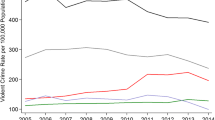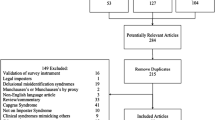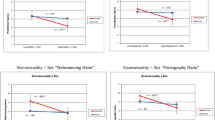Abstract
LGBTQ (lesbian, gay, bisexual, transgender, and queer-identified) employees commonly experience sexual harassment at work. The perceptions of lay observers of this harassment, such as their coworkers and managers, likely influence beliefs about appropriate individual and organizational responses to harassment. Thus, we conducted an experiment (n = 279 U.S. college students) to examine (a) whether four motivations (power, prejudice, gender policing, and sexual attraction) were perceived to underlie harassment toward LGT individuals; (b) how these motivations were related to perceived acceptability of the harassment; and (c) and how acceptability was related to recommended responses to the harassment. We found that compared to lesbian, gay, or cisgender heterosexual targets, participants perceived harassment toward transgender targets as less acceptable when they viewed it as more motivated by power and prejudice and less by attraction. Compared to male targets, participants perceived sexual harassment toward female targets as less acceptable when they viewed it as more motivated by prejudice. Finally, perceiving the harassment as less acceptable was associated with recommending that the target report the harassment. These results suggest that harassment targeting men and gay and lesbian employees may be minimized, underlining the need for organizations to protect against employees’ mistreatment and challenge beliefs about sexual harassment motivations and acceptability.

Similar content being viewed by others
References
Antecol, H., & Cobb-Clark, D. (2001). Men, women, and sexual harassment in the U.S. military. Gender Issues, 19, 3–18. https://doi.org/10.1007/s12147-001-0001-1.
Berdahl, J. L. (2007a). The sexual harassment of uppity women. Journal of Applied Psychology, 92(2), 425–437. https://doi.org/10.1037/0021-9010.92.2.425.
Berdahl, J. L. (2007b). Harassment based on sex: Protecting social status in the context of gender hierarchy. Academy of Management Review, 32, 641–658. https://doi.org/10.2307/20159319.
Bobbitt-Zeher, D. (2011). Gender discrimination at work connecting gender stereotypes, institutional policies, and gender composition of workplace. Gender & Society, 25(6), 764–786. https://doi.org/10.1177/0891243211424741.
Buchanan, N. T., & Fitzgerald, L. F. (2008). The effects of racial and sexual harassment on work and the psychological well-being of African American women. Journal of Occupational Health Psychology, 13(2), 137–151. https://doi.org/10.1037/1076-8998.13.2.137.
Buchanan, N. T., Settles, I. H., Hall, A. T., & O’Connor, R. (2014). A review of organizational strategies for reducing sexual harassment: Insights from the U. S. Military. Journal of Social Issues, 70, 687–702. https://doi.org/10.1111/josi.12086.
Buchanan, N. T., Settles, I. H., & Woods, K. C. (2008). Comparing sexual harassment subtypes for black and white women: Double jeopardy, the Jezebel, and the cult of true womanhood. Psychology of Women Quarterly, 32, 347–361. https://doi.org/10.1111/j.1471-6402.2008.00450.x.
Burgess, D., & Borgida, E. (1997). Refining sex-role spillover theory: The role of gender subtypes and harasser attributions. Social Cognition, 15(4), 291–311. https://doi.org/10.1521/soco.1997.15.4.291.
Butler, A. M., & Chung-Yan, G. (2011). The influence of sexual harassment frequency and perceptions of organizational justice on victim responses to sexual harassment. European Journal of Work and Organizational Psychology, 20(6), 729–754. https://doi.org/10.1080/1359432X.2010.507351.
Cantisano, G. T., Domínguez, J. M., & Depolo, M. (2008). Perceived sexual harassment at work: Meta-analysis and structural model of antecedents and consequences. The Spanish Journal of Psychology, 11(1), 207–218. https://doi.org/10.1017/S113874160000425X.
Cleveland, J. N., & Kerst, M. E. (1993). Sexual harassment and perceptions of power: An under articulated relationship. Journal of Vocational Behavior, 42(1), 49–67. https://doi.org/10.1006/jvbe.1993.1004.
Coffman, K. B., Coffman, L. C., & Ericson, K. M. M. (2016). The size of the LGBT population and the magnitude of antigay sentiment are substantially underestimated. Management Science, 63, 3168–3186. https://doi.org/10.1287/mnsc.2016.2503.
Cortina, L. M. (2008). Unseen injustice: Incivility as modern discrimination in organizations. The Academy of Management Review, 33, 55–75. https://doi.org/10.5465/AMR.2008.27745097.
Cortina, L. M., & Berdahl, J. L. (2008). Sexual harassment in organizations: A decade of research in review. In C. L. Cooper & J. Barling (Eds.), Handbook of organizational behavior (Vol. 1, pp. 469–497). Los Angeles: Sage Publications.
Costa-Lopes, R., Dovidio, J. F., Pereira, C. R., & Jost, J. T. (2013). Social psychological perspectives on the legitimation of social inequality: Past, present and future. European Journal of Social Psychology, 43(4), 229–237. https://doi.org/10.1002/ejsp.1966.
Culbertson, A. L., Rosenfeld, P., Booth-Kewley, S., & Magnusson, P. (1992). Assessment of sexual harassment in the navy: Results of the 1989 navy-wide survey (TR-92-1 I). San Diego, CA: Navy Personnel Research and Development Center.
DeSouza, E., & Solberg, J. (2004). Women’s and men’s reactions to man-on-man sexual harassment: Does the sexual orientation of the victim matter? Sex Roles, 50(9/10), 623–639.
Dunton, B. C., & Fazio, R. H. (1997). An individual difference measure of motivation to control prejudiced reactions. Personality and Social Psychology Bulletin, 23(3), 316–326. https://doi.org/10.1177/0146167297233009.
Fain, T. C., & Anderton, D. L. (1987). Sexual harassment: Organizational context and diffuse status. Sex Roles, 17(5–6), 291–311.
Fitzgerald, L. F. (1993). Sexual harassment: Violence against women in the workplace. American Psychologist, 48, 1070–1076. https://doi.org/10.1037/0003-066X.48.10.1070.
Funk, L. C., & Werhun, C. D. (2011). “You’re such a girl!” the psychological drain of the gender-role harassment of men. Sex Roles, 65, 13–22. https://doi.org/10.1007/s11199-011-9948-x.
Gates, G. J. (2013). Demographics and LGBT health. Journal of Health and Social Behavior, 54(1), 72–74. https://doi.org/10.1177/0022146512474429.
Gerhardstein, K. R., & Anderson, V. N. (2010). There’s more than meets the eye: Facial appearance and evaluations of transsexual people. Sex Roles, 62, 361–373. https://doi.org/10.1007/s11199-010-9746-x.
Glick, P., & Fiske, S. T. (2001). An ambivalent alliance: Hostile and benevolent sexism as complementary justifications for gender inequality. American Psychologist, 56(2), 109–118 http://dx.doi.org.proxy.lib.umich.edu/10.1037/0003-066X.56.2.109.
Glomb, S. M., & Espelage, D. L. (2005). The influence of restrictive emotionality in men's emotional appraisal of sexual harassment: A gender role interpretation. Psychology of Men & Masculinity, 6(4), 240–253. https://doi.org/10.1037/1524-9220.6.4.240.
Grant, J., Mottet, L., Tanis, J., Harrison, J., Herman, J., & Keisling, M. (2011). Injustice at every turn: A report of the national transgender discrimination survey. Washington, D.C.: National Center for Transgender Equality and National Gay and Lesbian Task Force.
Grauerholz, E. (1989). Sexual harassment of women professors by students: Exploring the dynamics of power, authority, and gender in a university setting. Sex Roles, 21(11–12), 789–801.
Gruber, J. E., & Fineran, S. (2008). Comparing the impact of bullying and sexual harassment victimization on the mental and physical health of adolescents. Sex Roles, 59, 1–13. https://doi.org/10.1007/s11199-008-9431-5.
Gutek, B. A., & Morasch, B. (1982). Sex-ratios, sex-role spillover, and sexual harassment of women at work. Journal of Social Issues, 38(4), 55–74. https://doi.org/10.1111/j.1540-4560.1982.tb01910.x.
Hayes, A. F. (2012). PROCESS: A versatile computational tool for observed variable mediation, moderation, and conditional process modeling [White paper]. Retrieved from http://www.afhayes.com/public/process2012.pdf.
Hayes, A. F., & Preacher, K. J. (2014). Statistical mediation analysis with a multicategorical independent variable. British Journal of Mathematical and Statistical Psychology, 67(3), 451–470. https://doi.org/10.1111/bmsp.12028.
Hendrix, W. H., Rueb, J. D., & Steel, R. P. (1988). Sexual harassment and gender differences. Journal of Social Behavior and Personality, 13, 235–252.
Henry, P. J. (2008). College sophomores in the laboratory redux: Influences of a narrow database on social psychology’s view of the nature of prejudice. Psychology Inquiry, 19, 114–125. https://doi.org/10.1080/10478400802049936.
Herek, G. M. (1996). Why tell if you’re not asked? Self-disclosure, intergroup contact, and heterosexuals’ attitudes toward lesbians and gay men. In G. M. Herek, J. Jobe, & R. Carney (Eds.), Out in force; sexual orientation and the military (pp. 197–225). Chicago: University of Chicago Press.
Herek, G. M. (2000). Sexual prejudice and gender: Do heterosexuals' attitudes toward lesbians and gay men differ? Journal of Social Issues, 56(2), 251–266. https://doi.org/10.1111/0022-4537.00164.
Herrera, A., Herrera, C., & Exposito, F. (2016). Is the beautiful always so good? Influence of physical attractiveness on the social perception of sexual harassment. International Journal of Social Psychology, 31(2), 224–253. https://doi.org/10.1080/02134748.2016.1143179.
Hill, C., & Silva, E. (2005). Drawing the line: Sexual harassment on campus. Washington, D.C.: American Association of University Women Educational Foundation.
Hitlan, R. T., Schneider, K. T., & Walsh, B. M. (2006). Upsetting behavior: Reactions to personal and bystander sexual harassment experiences. Sex Roles, 55, 187–195. https://doi.org/10.1007/s11199-006-9072-5.
Hurt, J. L., Maver, J. A., & Hoffman, D. (1999). Situational and individual influences on judgements of hostile environment sexual harassment. Journal of Applied Social Psychology, 29(7), 1395–1415.
Ilies, R., Hauserman, N., Schwochau, S., & Stibal, J. (2003). Reported incidence rates of work related sexual harassment in the United States: Using meta-analysis to explain reported rate disparities. Personnel Psychology, 56, 607–631. https://doi.org/10.1111/j.1744-6570.2003.tb00752.x.
Isbell, L. M., Swedish, K., & Gazan, D. B. (2005). Who says it’s sexual harassment? The effects of gender and likelihood to sexually harass on legal judgments of sexual harassment. Journal of Applied Social Psychology, 35(4), 745–772.
Konik, J., & Cortina, L. M. (2008). Policing gender at work: Intersections of harassment based on sex and sexuality. Social Justice Research, 21, 313–337. https://doi.org/10.1007/s11211-008-0074-z.
Labuski, C., & Keo-Meier, C. (2015). The (mis) measure of trans. Transgender Studies Quarterly, 2, 13–33. https://doi.org/10.1215/23289252-2848868.
Lapierre, L. M., Spector, P. E., & Leck, J. D. (2005). Sexual versus nonsexual workplace aggression and victims’ overall job satisfaction: A meta-analysis. Journal of Occupational Health Psychology, 10, 155–169. https://doi.org/10.1037/1076-8998.10.2.155.
Leskinen, E. A., Cortina, L. M., & Kabat, D. B. (2011). Gender harassment: Broadening our understanding of sex-based harassment at work. Law and Human Behavior, 35(1), 25–39. https://doi.org/10.1007/s10979-010-9241-5.
Lim, S., & Cortina, L. M. (2005). Interpersonal mistreatment in the workplace: The interface and impact of general incivility and sexual harassment. Journal of Applied Psychology, 90(3), 483–496. https://doi.org/10.1037/0021-9010.90.3.483.
Loy, P. H., & Stewart, L. P. (1984). The extent and effects of the sexual harassment of working women. Sociological Focus, 17, 31–43. https://doi.org/10.1080/00380237.1984.10570460.
McDonald, P. (2012). Workplace sexual harassment 30 years on: A review of the literature. International Journal of Management Reviews, 14, 1–17. https://doi.org/10.1111/j.1468-2370.2011.00300.x.
McFadden, C. (2015). Lesbian, gay, bisexual, and transgender careers and human resource development: A systematic literature review. Human Resource Development Review, 14(2), 125–162. https://doi.org/10.1177/1534484314549456.
Mellon, R. C. (2013). On the motivation of quid pro quo sexual harassment in men: Relation to masculine gender role stress. Journal of Applied Social Psychology, 43, 2287–2296. https://doi.org/10.1111/jasp.12178.
Mitchell, K. J., Yabarra, M. L., & Korchmaros, J. D. (2014). Sexual harassment among adolescents of different sexual orientations and gender identities. Child Abuse & Neglect, 38, 280–295. https://doi.org/10.1016/j.chiabu.2013.09.008.
Monteith, M. J., Arthur, S. A., & Flynn, S. M. (2010). Self-regulation and bias. In J. F. Dovidio, M. Hewstone, P. Glick, & V. M. Esses (Eds.), SAGE handbook of prejudice, stereotyping, and discrimination (pp. 493–507). London: Sage.
Munson, L. J., Hulin, C., & Drasgow, F. (2000). Longitudinal analysis of dispositional influences and sexual harassment: Effects on job and psychological outcomes. Personnel Psychology, 53(1), 21–46. https://doi.org/10.1111/j.1744-6570.2000.tb00192.x.
Nagoshi, J. L., Brzuzy, S., & Terrell, H. (2012). Perceptions of gender roles, gender identity, and sexual orientation among transgender individuals. Feminism and Psychology, 22, 405–422. https://doi.org/10.1177/0959353512461929.
Norton, A. T., & Herek, G. M. (2013). Heterosexuals’ attitudes toward transgender people: Findings from a national probability sample of US adults. Sex Roles, 68(11–12), 738–753. https://doi.org/10.1007/s11199-011-0110-6.
Paludi, C. A., & Paludi, M. (2003). Academic and workplace sexual harassment: A handbook of cultural, social science, management, and legal perspectives. Westport, CT: Praeger.
Preacher, K. J., & Hayes, A. F. (2008). Asymptotic and resampling strategies for assessing and comparing indirect effects in multiple mediator models. Behavior Research Methods, 40(3), 879–891. https://doi.org/10.3758/BRM.40.3.879.
Pryor, J. B. (1985). The lay person's understanding of sexual harassment. Sex Roles, 13(5–6), 273–286. https://doi.org/10.1007/BF00288085.
Pryor, J. B., & Day, J. D. (1988). Interpretations of sexual harassment: An attributional analysis. Sex Roles, 18(7–8), 405–417. https://doi.org/10.1007/BF00288392.
Rabelo, V. C., & Cortina, L. M. (2014). Two sides of the same coin: Gender harassment and heterosexist harassment in LGBQ work lives. Law and Human Behavior, 38(4), 378–391. https://doi.org/10.1037/lhb0000087.
Ragins, B. R., & Cornwell, J. M. (2001). Pink triangles: Antecedents and consequences of perceived workplace discrimination against gay and lesbian employees. Journal of Applied Psychology, 86(6), 1244–1261. https://doi.org/10.1037//0021-9010.86.6.1244.
Rotundo, M., Nguyen, D. H., & Sackett, P. R. (2001). A meta-analytic review of gender differences in perceptions of sexual harassment. Journal of Applied Psychology, 86(5), 914–922. https://doi.org/10.1037/0021-9010.86.5.914.
Runtz, M. G., & O'Donnell, C. W. (2003). Students’ perceptions of sexual harassment: Is it harassment only if the offender is a man and the victim is a woman? Journal of Applied Social Psychology, 33(5), 963–982. https://doi.org/10.1111/j.1559-1816.2003.tb01934.x.
Russell, B. L., & Trigg, K. (2004). Tolerance of sexual harassment: An examination of gender differences, ambivalent sexism, social dominance, and gender roles. Sex Roles, 50, 565–573.
Serano, J. (2013). Excluded: Making feminist and queer movements more inclusive. Berkeley, CA: Seal Press.
Settles, I. H., Buchanan, N. T., & Colar, B. K. (2012). The impact of race and rank on the sexual harassment of black and white men in the military. Psychology of Men and Masculinity, 13, 256–263. https://doi.org/10.1037/a0024606.
Shechory Bitton, M., & Ben Shaul, D. (2013). Perceptions and attitudes to sexual harassment: An examination of sex differences and the sex composition of the harasser–target dyad. Journal of Applied Social Psychology, 43, 2136–2145. https://doi.org/10.1111/jasp.12166.
Silverschanz, P., Cortina, L. M., Konik, J., & Magley, V. J. (2008). Slurs, snubs, and queer jokes: Incidence and impact of heterosexist harassment in academia. Sex Roles, 58, 179–191. https://doi.org/10.1007/s11199-007-9329-7.
Smirles, K. E. (2004). Attributions of responsibility in cases of sexual harassment: The person and the situation. Journal of Applied Social Psychology, 34(2), 342–365. https://doi.org/10.1111/j.1559-1816.2004.tb02551.x.
Sojo, V. E., Wood, R. E., & Genat, A. E. (2016). Harmful workplace experiences and women’s occupational well-being: A meta-analysis. Psychology of Women Quarterly, 40(1), 10–40. https://doi.org/10.1177/0361684315599346.
Tangri, S. S., & Hayes, S. M. (1997). Theories of sexual harassment. In W. O’Donohue (Ed.), Sexual harassment: Theory, research, and treatment (pp. 112–128). Needham, MA: Allyn & Bacon.
Taylor, E. A., Hardin, R., & Rode, C. R. (2017). Contrapower harassment in the sport management classroom. NASPA Journal About Women in Higher Education, 00, 1–16. https://doi.org/10.1080/19407882.2017.1378113.
Thomann, D. A., & Wiener, R. L. (1987). Physical and psychological causality as determinants of culpability in sexual harassment cases. Sex Roles, 17(9–10), 573–591. https://doi.org/10.1007/BF00287737.
U.S. Merit Systems Protection Board. (2004). Issues of merit. Retrieved from http://www.mspb.gov/netsearch/viewdocs.aspx?docnumber=255805&version=256094&application=ACROBAT
van Anders, S. M. (2015). Beyond sexual orientation: Integrating gender/sex and diverse sexualities via sexual configurations theory. Archives of Sexual Behavior, 44, 1177–1213. https://doi.org/10.1007/s10508-015-0490-8.
Waldo, C. R., Berdahl, J. L., & Fitzgerald, L. F. (1998). Are men sexually harassed? If so, by whom? Law and Human Behavior, 22, 59–79. https://doi.org/10.1023/A:1025776705629.
Weitzman, L. J. (1979). Sex role socialization: A focus on women. Palo Alto, CA: Mayfield Publishing Company.
Wilkerson, J. M. (1999). The impact of job level and prior training on sexual harassment labeling and remedy choice. Journal of Applied Social Psychology, 29(8), 1605–1623. https://doi.org/10.1111/j.1559-1816.1999.tb02044.x.
Williams, C. W., Brown, R. S., Lees-Haley, P. R., & Price, J. R. (1995). An attributional (causal dimensional) analysis of perceptions of sexual harassment. Journal of Applied Social Psychology, 25(13), 1169–1183. https://doi.org/10.1111/j.1559-1816.1995.tb02612.x.
Willness, C. R., Steel, P., & Lee, K. (2007). A meta-analysis of the antecedents and consequences of workplace sexual harassment. Personnel Psychology, 60, 127–247. https://doi.org/10.1111/j.1744-6570.2007.00067.x.
Acknowledgements
Portions of this manuscript were completed while NiCole T. Buchanan was on sabbatical leave as a Senior Visiting Scholar with the University of Michigan’s Institute for Research on Women and Gender and the Department of Psychology.
Author information
Authors and Affiliations
Corresponding author
Ethics declarations
All APA standards for the treatment of participants were followed when conducting the research upon which this manuscript is based (including informed consent). Additionally, this manuscript has not been published elsewhere in whole or in part. The authors have no known conflicts of interest.
Rights and permissions
About this article
Cite this article
Brassel, S.T., Settles, I.H. & Buchanan, N.T. Lay (Mis)Perceptions of Sexual Harassment toward Transgender, Lesbian, and Gay Employees. Sex Roles 80, 76–90 (2019). https://doi.org/10.1007/s11199-018-0914-8
Published:
Issue Date:
DOI: https://doi.org/10.1007/s11199-018-0914-8




